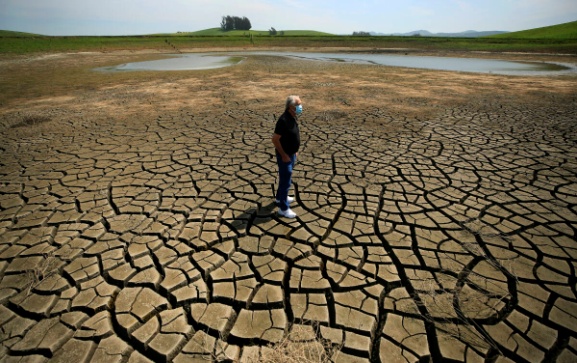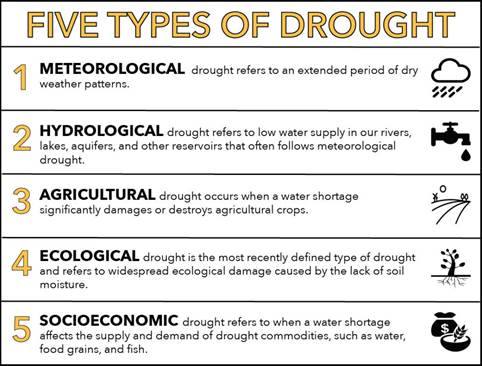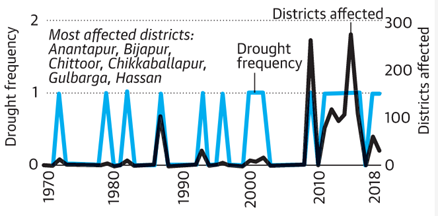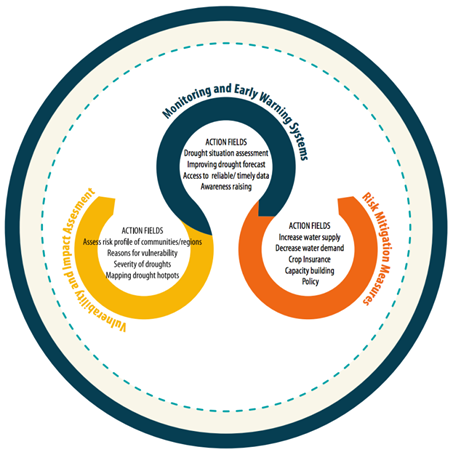DROUGHT

Disclaimer: Copyright infringement not intended.
Context
- Two-thirds of Europe is under some sort of drought warning, in what is likely the worst such event in 500 years.
Details of the Report
- The latest report from the Global Drought Observatory says 47% of the continent is in "warning" conditions, meaning soil has dried up.Another 17% is on alert - meaning vegetation "shows signs of stress".
- The report warns that the dry spell will hit crop yields, spark wildfires, and may last several months more in some of Europe's southern regions.
- Compared with the average of the previous five years, EU forecasts for harvest are down 16% for grain maize, 15% for soybeans and 12% for sunflowers.
- Some of Europe’s biggest rivers — Rhine, Po, Loire, Danube — which are usually formidable waterways, are unable to support even mid-sized boats. As water levels have fallen, remains of sunken ships and rocks have emerged to the surface.
- Dry rivers are also hitting the energy sector, which is already in crisis. Hydroelectric power has dropped by a significant 20%.
- The ongoing heatwave and water shortages have "created an unprecedented stress on water levels in the entire EU.
- The report warns that the situation is worsening in countries including Italy, Spain, Portugal, France, Germany, the Netherlands, Belgium, Luxembourg, Romania, Hungary, northern Serbia, Ukraine, Moldova, Ireland and the UK.
- In the UK, which had an official drought declared in several regions, some trees have turned an autumnal shade of auburn - in what's considered a "false autumn" due to the heat.
- A "severe drought" has been present in many places all year, but "has been further expanding and worsening.
- Preliminary data suggests "the current drought still appears to be the worst since at least 500 years".
Drought
- A drought is defined as "a period of abnormally dry weather sufficiently prolonged for the lack of water to cause serious hydrologic imbalance in the affected area." A drought can last for months or years.
- It can have a substantial impact on the ecosystem and agriculture of the affected region[5] and cause harm to the local economy.

Various Causes of Droughts
Lack or insufficient rainfall (or precipitation)
This is the major cause of droughts in most regions. A long-drawn-out period without rainfall can cause an area to dry out. The quantity of water vapor in the atmosphere pretty much impacts the precipitation of an area. When a region has moist and low-pressure systems, there is huge probability that rain, hail, and snow will occur. The exact opposite would happen when the region has high-pressure systems, and less water vapor. Farmers plant crops in anticipation of rains, and so when the rains fail, and irrigation systems are not in place, agricultural drought happens.
Changes in climate
Changes in climate, for instance, global warming can contribute to droughts. Global warming is likely to impact the whole world, especially third world economies. Most governments have tried to play down the fact that the earth’s temperature has significantly increased. But scientists have proven, without doubt, that human activities are the main contributors to the increase in greenhouse gasses to the atmosphere. This increase in greenhouse gasses has resulted in warmer temperatures. Warmer temperatures are recipes for dryness and bushfires. These set of conditions mightily contribute to prolonged droughts.
Human activities
Forests are critical components of the water cycle. They help store water, minimize evaporation, and contribute a great deal of atmospheric moisture in the form of transpiration. This, in essence, implies that deforestation, aimed at uplifting the economic status of a region, will expose vast quantities of water to evaporation. Cutting down trees will also take away the capability of the ground to retain water and allow desertification to occur easily. Deforestation also greatly minimizes watershed potential. Over-farming is another human activity contributing to droughts. Over-farming loosens the soil allowing erosion to take place. Soil erosion compromises the capacity of soil to hold water.
Overexploitation of surface water resources
Specific areas are endowed with surface water resources like rivers and streams whose sources are watersheds and mountains. These surface water resources could dry out if their main sources are interfered with. Irrigation systems and hydroelectric dams are just some of the aspects that contribute to over-exploitation of surface water resources. They also cut off supply of water to downstream communities.
Harmful Effects of Droughts
Economic Effects
- Economic effects of droughts usually involve loss of money by governments, enterprises, families or individuals. Below is an outline of the main economic impacts of droughts:
- Farmers will have to contend with spending huge sums of money for irrigation and watering animals. This involves drilling wells or buying water from far distances.
- Low yields equal loss of substantial income. Low yields also lead to pay cuts and layoffs to farm workers.
- Businesses and industries that produce farm equipment may close down since farmers have no money to purchase equipment.
- Prolonged shortage of rains means drier conditions. This makes an area susceptible to wildfires. Wildfires can destroy property; devastate farms and burn down forests. Governments spend millions to control or put out wildfires annually. All this affects the economy of the region.
- If water supply plummets, hydropower plants operate below capacity, and this means businesses have to pay more for electricity or incur the cost of using their own generators. Energy firms also lose out since they are unable to satisfy energy demands of the region. The government also loses a big chunk of tax revenue.
Environmental Effects
- Droughts lead to decimation of habitats. Water bodies such as rivers, lakes, ponds, lagoons, and creeks dry out, and this leads to death of water animals.
- Soil moisture is critical to the breakdown of organic matter. Droughts compromise soil quality since there is less to zero organic activity because organisms have died.
- Droughts magnify the impacts of desertification by wiping out any chance of land recovering.
- The quality and health of surface water bodies such as rivers, streams, lakes, and ponds are enormously impacted. This endangers living organisms depending on the water for survival.
- Wildlife walk long distances in search of water. They end up in new dangerous habitats that can lead to their demise.
Social Effects
- The social effects of drought are the most potent since they directly impact humans. Many in the third world countries that have experienced drought can attest to their severity.
- Water maintains our health. Sanitation and clean drinking water are critical to a healthy body. Droughts lead to malnutrition, anemia, and hunger.
- Droughts trigger migrations. This means the area will lack young and working population, a critical ingredient to the development of any region.
- Lack of control over when the drought ends can have far-reaching psychological effects like stress, anxiety, and depression. Social interaction reduces and community networks get broken.
Drought as Global Issue
- The number and duration of droughts around the world have increased by an alarming 29% since 2000.
- The upward trajectory in the duration of droughts and the severity of impacts, not only affects human societies but also the ecological systems upon which the survival of all life depends, including that of our species.
- According to World Bank estimates, drought conditions can force up to 216 million peopleto migrate by 2050. Other factors at play along with drought could be water scarcity, declining crop productivity, rise in sea levels, and overpopulation.
- As per the World Meteorological Organisation, weather, climate and water hazards have accounted for 50% of all disasters and 45% of all reported deathssince 1970.
- Between 2020 and 2022, 23 countries have faced drought emergencies.
- Climate change alone will cause 129 countries to experience an increase in drought exposurein the next few decades.
- The World Health Organisation (WHO) also noted that approximately 55 million people are directly affected by droughts annually, making it the most serious hazard to livestock and crops in almost every part of the world.
- According to a 2017 report by the Food and Agriculture Organisation, the percentage of plants affected by drought has more than doubled in the last 40 years.
- Droughts and climate change are intensifying the incidence of wildfires that devastated roughly 30 million acres of land in the global north and south from 2018-2020 alone, causing significant losses in livelihoods, health and biodiversity.
- By 2025, two-thirds of the world could be living under water-stressed conditions, with 1.8 billion people experiencing absolute water scarcity.
Stats (India specific)
- The chart shows the number of extreme droughts (left axis) and the number of districts affected (right axis).
- Since 2000, there has been a sharp increase in the number of drought-hit districts.

Steps being taken
- THE DELHI DECLARATION OF 2019, signed by 14th CoP of the UNCCD, called for better access and stewardship over land, and emphasised gender-sensitive transformative projects.
- THE BONN CHALLENGE: To bring 150 million hectares of the world’s deforested and degraded land into restoration by 2020, and 350 million hectares by 2030.
- GREAT GREEN WALL: Initiative by Global Environment Facility (GEF), where eleven countries in Sahel-Saharan Africa have focused efforts to fight against land degradation and revive native plant life to the landscape.
- PEACE FOREST INITIATIVE: It is an initiative of South Korea to use ecological restoration as a peacebuilding process and aims at addressing the issue of land degradation in conflict-torn border areas.
- INTERNATIONAL COALITION FOR ACTION ON SAND AND DUST STORMS (SDS): SDS source base map will be developed with the goal of improving monitoring and response to these storms.
Steps being taken by India
- Integrated Watershed Management Programme
- National Afforestation Programme
- National Mission for Green India
- NREGA
- Soil Conservation in the Catchment of River Valley Project
- National Watershed Development Project for Rainfed Areas
- Fodder and Feed Development Scheme
- Command Area Development and Water Management programme
- Soil Health Card Scheme
Drought: reducing impacts and building resilience
- The adoption of national drought policies that are focused on risk reduction and which are complemented by drought mitigation plans at various levels of government will have significant ripple effects across key sectors.
- The adoption of these policies supports the implementation of Sustainable Development Goal target 6 – “ensure availability and sustainable management of water and sanitation for all” – by promoting integrated water resources management. The vulnerability to future drought episodes can be significantly reduced and the coping capacity of communities, even entire nations, can be improved.
A proactive approach for enhancing drought resilience is composed of three important pillars:
- Drought monitoring and early warning systems
- Vulnerability and risk assessment
- Drought risk mitigation measures

Vulnerability and risk assessment
Vulnerability is a condition resulting from social, economic, and environmental factors or processes, which increases the susceptibility of a system to the impacts of drought hazard. Vulnerability assessment is needed to understand “who and what is at risk and why?”
Some of the important features of vulnerability assessment include:
- Recording drought impacts on vulnerable economic sectors, including rain-fed and irrigated agriculture, livestock, environment, energy, tourism and health sectors
- Assessing the reasons for vulnerability and the conditions that impact the resistance of a system to drought
- Assessing the degree or extent of potential damage or loss in the event of a drought
- Assessing the coping capacity of communities affected by drought
- Assessing sectors, population groups, and ecosystems most at risk and identifying appropriate and reasonable mitigation measures to address these risks
- To reduce vulnerability to drought, it is essential to identify the relevant impacts and assess their underlying causes.
- Information on drought impacts and their causes is crucial for reducing risk before drought occurs and for appropriate response during and after drought. It is important to combine forecasts with detailed knowledge on how landscapes and societies respond to a lack of rain and to turn that knowledge into prompt action within weeks or even days.
Drought risk mitigation measures
- There are practical measures that can be taken starting immediately. Both measures and actions – also called drought risk management options – that either build greater resilience to drought or reduce the impacts of drought when it occurs can be deployed.
- These measures and actions involve approaches promoted by the UNCCD as they involve strengthening natural infrastructure and the integrated management of land and water resources.
Examples of important mitigations measures include:
- Water harvesting, protecting water sources against contamination, developing water sources – such as micro dams, ponds and wells, use of reserve sources of groundwater and water rationing/allocation
- Restoring pastures and balancing land and water resources
- Recovering the water holding capacity of soils through tree planting (including fruit trees) and the protection of riverbanks and wetlands
- Implementing Integrated Water Resources Management (IWRM), such as mitigating upstream-downstream user conflicts and coordinating between water users, communities and sectors
- Enhancing irrigation schemes
- Diversifying rural livelihoods through social protection, cash-transfer programs or improving access to markets and rural services: Access to markets could help create alternative non-farm employment that could reduce the impacts of droughts
- Crop insurance
- Shifting to drought tolerant crops
- Managing livestock production within the landscape, including the relocation of herds, nomadic migrations and use of special reserved areas
Drought management
- In many countries, drought awareness is limited and institutional capacities need to be strengthened by promoting public awareness and strengthening capacities of both the citizens and institutions especially at the local level: farmers, pastoralists and all those actors and stakeholders involved in decision making. Local citizens and institutions, in particular, need help to identify and disseminate good practices that work in local conditions.
- By being proactive, investing in early warning systems and assessing their vulnerability, countries can emphasize protection rather than recovery.
- Integrated drought early-warning and monitoring systems that capture information on the incidence and severity of droughts can better identify vulnerable population groups and geographic regions. This facilitates early action and can lead to the development and implementation of a wide variety of mitigation actions including better land management to reduce impacts from future drought events.
- Lastly, there is a need for greater cooperation and sharing of experience and success stories among countries. Well-planned and coordinated drought action will have a positive ripple effect across sectors and across borders. The poorest and most vulnerable parts of society will benefit the most.
Examples of drought mitigation measures:
- Strengthening Early Warning Systems for Drought (SEWS-D) project in Central America and the Caribbean:
- Survey on drought tolerant crops
Other steps
Immediate impact steps such as conservation of wetlands, rangelands and mangroves which absorb huge stocks of GHGs like CO2 from the atmosphere.
Long-term steps: Planting of trees, reforestation and afforestation.
Regenerative agriculture and restoring natural systems need a combination of traditional and modern practices, which offers great potential for job creation. Large-scale ecosystem restoration efforts have the potential to create up to 40 jobs for every 1 million dollars invested.
https://indianexpress.com/article/explained/explained-europes-great-drought-8107833/




1.png)
